Batman, Superman, and Wonder Woman might want to think of trading in their regular superhero capes for a swath of row cover. Because this fabric, as diaphanous as Anderson Cooper's temples, can protect against anything. Even the sinister Leek Moth.

You buy your leek and onion seedlings, maybe you even start the seeds yourself, and you spend hours planting hundreds of the tiny things in orderly rows. You water them, weed them and feed them. They are growing and looking great and you're quite prideful of the fact that you are the most talented gardener that ever lived. You should probably write a book.
And then one day as you wander around your garden, sporting your "I Garden So I Don't Kill People" t shirt, you notice things aren't looking quite right. Your onions or leeks seem a bit unhealthy. Maybe they just need water. So you water them.
A few days later they look less healthy. So you give them a gentle stroke with your magical, miraculous gardening hands and the entire plant top flops over. The neck is like mush, now that you take a closer look, and the leaves are scarred with some sort of stripes. You stand, staring down at the plants thinking - you are in fact the least talented gardener that ever lived. You should probably never write a book.
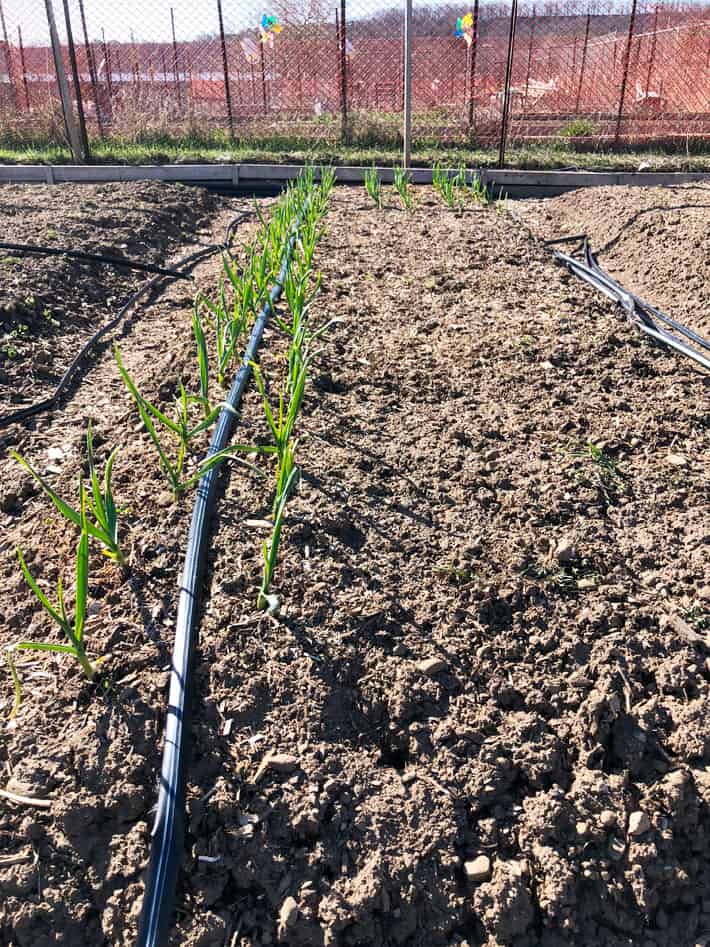
These same symptoms can come from a number of things, but if you live in parts of North America or Europe it's possible you're dealing with Leek Moths. Specifically their larvae.
The Leek Moth burrows into your onion, garlic and leeks leaving a hole in your bulbs as well as your heart. Months of gardening work GONE with entire crops decimated by the Leek Moth larvae.
Leek Moths started out in Europe where you'd think they'd have the good sense to stay. There's Paris and the French countryside, not to mention raucous, happening London. It's hard to believe a country like Denmark that produces women who can attract men like moths to a flame would fail at containing their ... moths. But in 1993 the Leek Moth left Europe and made its way to Canada.
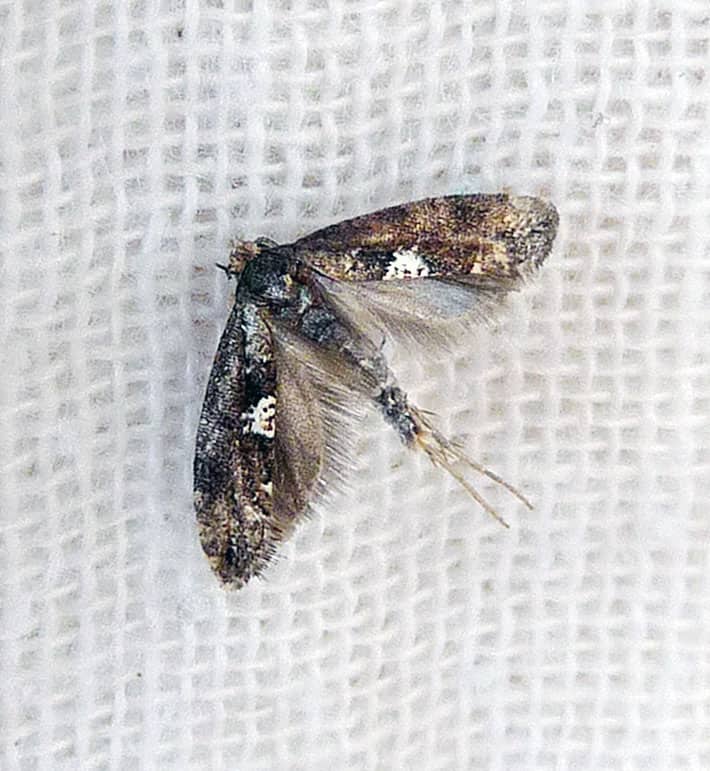
The stupid Leek Moth. - Wings open.
It was first found in Ottawa, the capital of Canada so it's entirely possible the moth came for a site seeing vacation as one does, and decided it was so nice it would move here. Canada being the most welcoming country with regard to immigrants, let the Leek Moth stay.
How Leek Moths Damage Plants
- Moths flit around in the spring and lay their eggs on allium type plants like garlic, leeks, onions and shallots.
- The eggs hatch and larvae emerge onto your plant where they proceed to eat and eat and eat. You'll notice damage on the leaves.
- Once they've had their fill they cocoon themselves onto the leaf of your plant where they pupate. They're easy to spot in this stage so SQUISH them.
- If left, the second generation will emerge and those are the ones that will eat all the way down to the bulb of the plant, making it rot before harvesting. If the neck of you plant is floppy - it's probably been infested with leek moth damage.
So now what? The Leek moth is in Ontario, Quebec and P.E.I in Canada and spreading. In the United States the Leek Moth can officially be found in New York,, Vermont but other unconfirmed areas are possible.
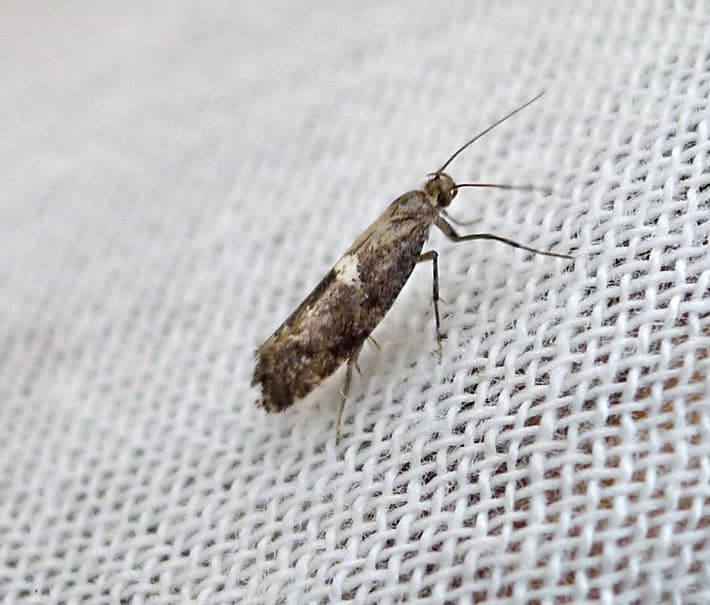
The stupid Leek Moth - Wings closed.
Cover your garlic. Immediately. If you're reading this at the end of spring I cannot stress enough how important it is for you to get your leeks, onions and garlic covered right now before the Leek Moth emerges and starts laying eggs all over your plants leaves.
Steps to Protect Against Leek Moth
- Spray crop with Bt (Bacillus thuringiensis), which is a natural bacteria found in soil. It's an organically approved and effective killer of moth larvae. It hurts no other insects or humans. Only moth larvae. Here's my tutorial on using Bt.
- Cover crop with floating row cover or insect netting.
- Monitor for Leek Moths with Pheromone traps.
- Utilize Leek Moth egg eating, parasitic wasps called Trichogramma.
1. Spray crops with Bt in case there happens to be any eggs laid on your crop already. If they hatch, the larvae will eat the leaves with Bt on it and die.
2. Cover your crop with floating row cover or insect netting. Hopefully you can do this BEFORE the leek moths emerge in the spring, if not you have some reassurance having sprayed with Bt.
Would you like to save this stuff?

2. After you lay the fabric over your crop, weigh the edges down with rocks.
TIP: Use floating row cover like the one I've linked to right here that has little or no thermal value. You don't want to heat the plants up, you just want to protect them from insects. The heavier the floating row cover the more thermal value it has. You want a LOW weight cover. Insect Netting is also great. It's a bit more expensive but a lot more durable and will last 3 or 4 seasons instead of just the one that a floating row cover is likely to last.
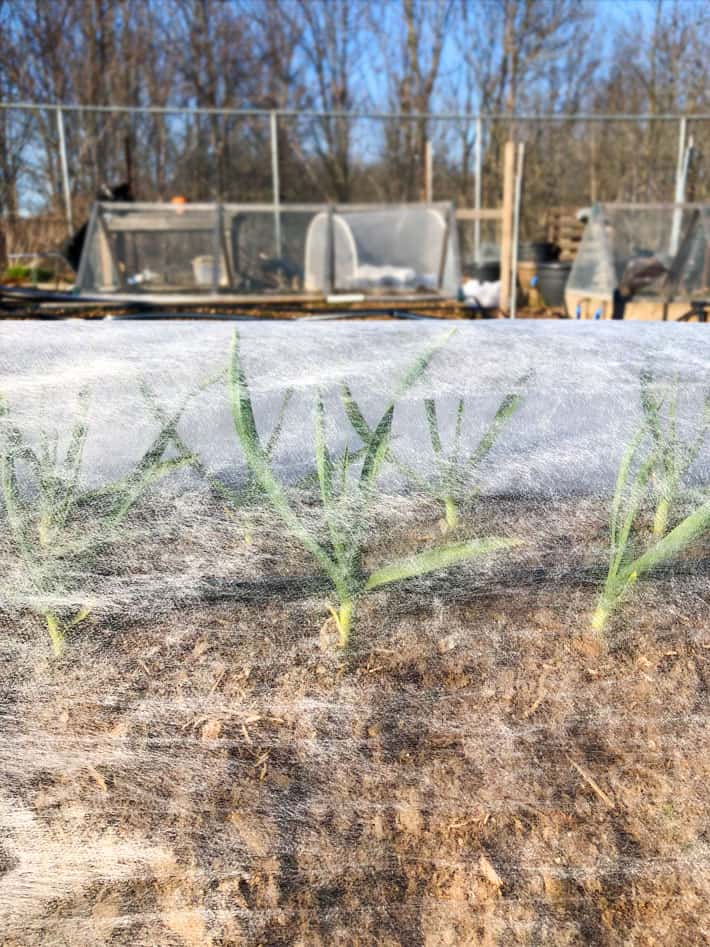
Don't worry. Both sun and rain can get through either covers. While the plants are small just lay it right on top of them. As they get bigger just loosen the cover and they'll push it up. You can also use hoops to hold the cover up which is the best option because when the fabric is laid right on the plant, insects can technically still get their little stingers through the fabric and deposit eggs on the plants.
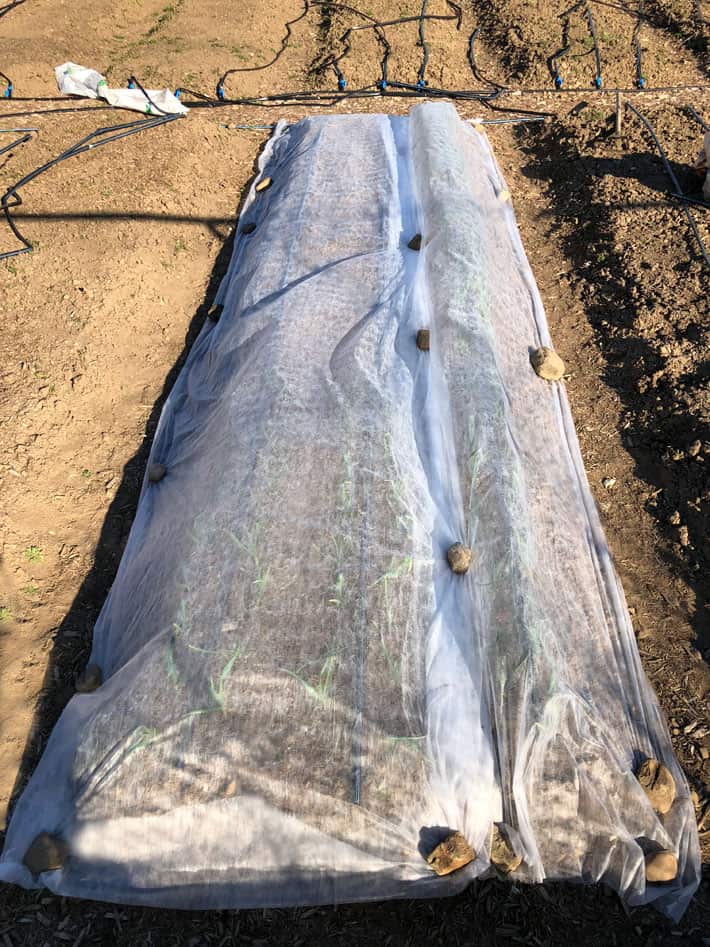
For now I just have the fabric laid down because I wanted to get it done as quickly as possible. Later I'll add some hoops to support the cover.
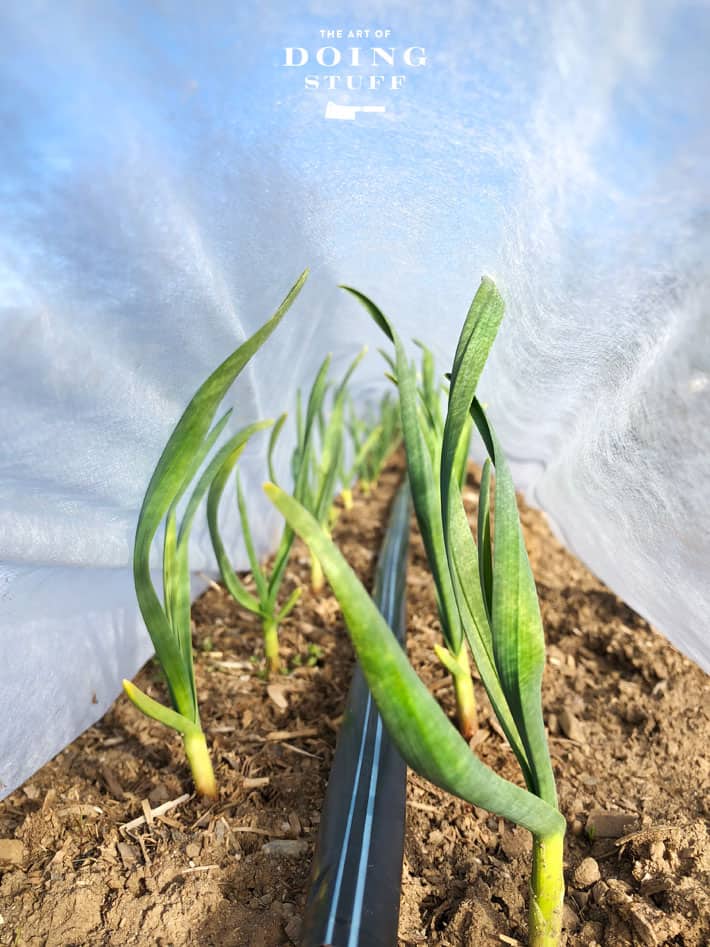
A cozy little Leek Moth bunker.
Because you're ALWAYS better off using 2 or 3 pest control options at the same time you also might want to think about getting parasitic wasps. They're what I use for controlling flies in my chicken coop, only these are a different variety of parasitic wasps.
The wasps for controlling Leek Moths (or Gypsy moths and a variety of other moths) are called Trichogramma. They're less than 1mm long and come delivered on a sticky trap. You set them by your crop at the same time that Leek Moths are laying eggs.
Leek Moths have 2-3 laying cycles in my area. They are generally first seen laying from late April to mid May depending on the weather. They will cycle again in June/July and July/August. The best way to know when they're in a cycle is to use Pheromone traps.
These traps will attract Leek Moths so when the traps start to get filled with Leek Moths you know they are in a cycle and it's time to put out a new card filled with Trichogramma.
If you can't find Leek Moth pheromone traps you'll have to watch for them yourself which is close to impossible. But if you're going to do this know that they are nocturnal so you'll have to monitor at night not during the day. You can also try setting out regular sticky traps without any pheromones and see if you see Leek Moths on them.

I know. That was a whole lot of information about a bug you might not even have.
But ...
All of these measures also help protect against Cabbage Moth/ Cabbage Worms, which is the green wormy caterpillar that mows its way through your kale, cabbage, broccoli, and cauliflower. It also has an alarmingly similar colour to all of those foods which makes it almost invisible.
If you're one of those hippie types who doesn't mind eating the odd caterpillar with your salad or side dish good for you. I prefer my salads to not ooze guts when I bite into it.
So which are you going to be this year? The most the most talented superhero, row cover cape wearing gardener that ever lived? Or the other one.
→Follow me on Instagram where I often make a fool of myself←
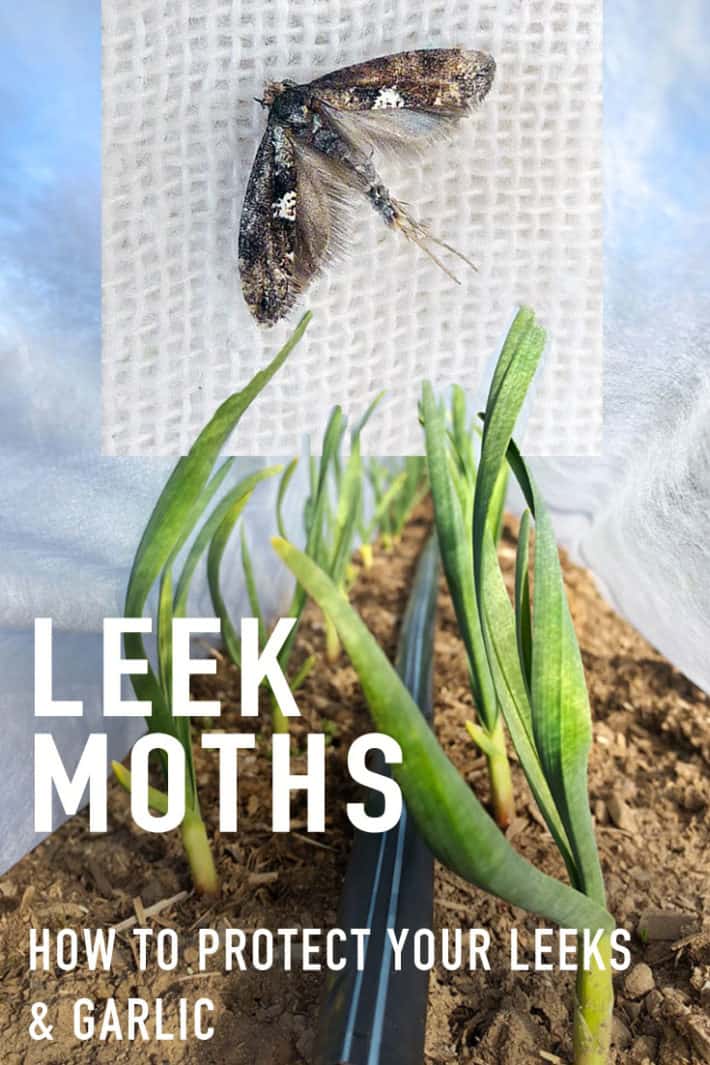




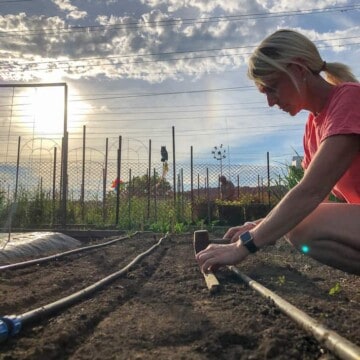
Heather
Thanks, Karen! You're my go-to gardening guru. I clicked the row covers link and bought BTK via Home Depot curbside. There are so many pests it's hard to keep up with them all. Yesterday, I took my little cucumber seedlings outside to repot them and within a minute there was a cucumber beetle on one of them. Last year, none of my cukes produced anything impressive. Too many pests. This year, I'm setting them out later in the season, and I'll try the BTK. Thanks, again!
Belinda
Karen,
You seem to get all the bad critters just before they make it into my garden. I will be ready for the arrival now. I always count on you for always teaching the best practices.
Ann Roberts
Maybe we are lucky, but here in South Central Tennessee we must not have this moth yet. I have grown all 3, leeks, garlic and onions for many years and have no issues at all with loss. In fact, nothing bothers my onions, garlic and some years, leeks.
But I do use row covers for many things. And shade cloth which also allows us to grow our cooler season crops a bit later in the spring and earlier in the fall than we could ever do without the shade cloth.
Lauren
I live in the GTA. I’ve found the pupa as well as the caterpillars. I am now covering at night. I’ve sprayed with BTK. Should I pull up all my plants? Or can I wait till harvest; examine all the bulbs. And rather than store them, maybe cook them all or freeze them since they won’t store well?
Lynn
Just found these on some of my garlic plants when I was cutting the scapes. I dug up 22 plants that I found signs of the leek moth. The bulbs seem ok, small but very hard. I realize too late for the parasite wasp but can I still spray with BTK and where do you get it. When I asked at out local green house they said I need to get a certified sprayer to do systematic drainage which would mean no longer organic garlic. I live in south western Ontario. Can you email me. Thank you.
Karen
Hi Lynn. Canadian Tire sells it. :) ~ karen!
Susan
In Canada you can get garden supplies at a tire store?! What a place! US tire stores just smell of rubber and grease. And only sell tires.
Suzanne
Karen, I will not even attempt to explain Canadian Tire. Your description will be much funnier!
Debbie
Canadian Tire is the hardware store that gets Canadians through the winters. You can get everything at Canadian Tire. They sell all kinds of dodads and tools for great prices and during the winter your hubby can disappear looking for deals on tools they already have. Plus, you get Canadian Tire money. Don’t ask
Lois
Hello,
I am interested in using the parasitic wasp solution.
Are they a native insect to southern Ontario, as I would not want to introduce a non-native to the area?
Kristin Ferguson
Question: I have now lost two hens to flystrike, and I NEVER WANT THIS TO HAPPEN EVER EVER AGAIN. I did order parasitic wasps, but the second time I did this I had a follow-up call with the company in which I explained that I'd lost a hen even though I used the wasps, and she said they don't work for green bottle flies. Can you help me understand which wasps to use and what flies they parasitize (Parasitise for Canadians)? I am trying to be diligent about cleaning their poop board, and washing their poopy butts, but shit literally happens, and flytrike is probably the most disgusting thing that's likely to happen to me in my life, and I've had two exposures. A third might kill me with grossness.
Karen
Hi Kristin. Oh lord, I'm so sorry about TWO of your hens. As you know, I can related. :( But I'm not sure what your parasitic wasp person is talking about. "Filth" flies are exactly what parasitic wasps are for. It's the whole point of them. To get rid of flies that occur in agriculture due to animal manure. That means blue and green bottle flies. I do know you can't rely on only this method and it's best to start the program the very second that fly season starts. So I started my parasitic wasps on the first days that it warmed up around here a couple of weeks ago. But I also still use fly traps. 2-3 methods for any pest is the way to go. But I'm still confused by your wasp person saying that these aren't for bottle flies. Do the wasps come to you packaged in a plastic bag inside of fly larvae? Or on a piece of cardboard? If they come on something like a piece of cardboard those are Trichogramma which are meant for cabbage moths etc. I'm really stumped as to why she's saying they aren't for filth flies. ~ karen!
Kristin Ferguson
I know! It was weird. But that's what she said. Both times the wasps came in a packet with wood shavings, I believe. They looked like tiny little dry mouse turds. Is this what you get? What product exactly do you buy? I do also use a fly trap and a bunch of vanilla air fresheners, plus I clean off the board under the roosting bar pretty much every day, and I keep an eye out for poopy butts. Some hens are prone to poopy butts, and others simply aren't! But I see tons of green iridescent flies all around the yard anyway.
Joy
Effin’ news. Hadn’t heard about this yet in Wisconsin, but of course now I’ll have to worry about it. Sigh. Onion family crops are what I grow best. So far.
Melody
Why don't you try a bug zapper light and annihilate the pesky things?
Nancy Ann Page
Oh heck, forgot the "a"........I really wanted to add, Tina, your personality needs editing, not that I give a darn, along with everybody else.
Nancy Ann Page
Tina! You're nitwit......hope I spelled that right and wasn't sexist....oh, never mind, I don't care.
Marie Anne Delia
Not planting this year due to a move coming up, but I still read the post because I knew it would still be entertaining and educational. Then the comments offered up another whole bunch of entertainment :) such wonderful readers...witty and loyal...love them and you Karen!
Sarah
I plant marigolds near my crops which seems to keep bugs away from my veg. Not a thing on my garlic, onions, broccoli or cauli last year. Have done the same this year, but actually haven't ever seen the leek moth. I live in Europe, too, so have obviously been lucky so far...I'll keep my fingers crossed, and maybe buy some BT just in case...
Mary W
Impossible for Karen to be sexist when she pictures herself with a huge pole - what? I feel like a 6th grade school boy who just heard the teacher say chicken breast in class.
danni
oh jeeeeeeeeez.... a new menace! As if the cabbage worms and squash bugs and cucumber beetles weren't enough!
And aphids.....
And the wretched squirrels....
And yet every year I still do it.
Eileen
Whaaaaaat????? (to the above comment,Tina) . I took the Denmark comment as being a compliment to Denmark women. And.......She is a humorist......and, in this case.....an educator. Lighten up.
Karen
And Danish. ;) ~ karen!
linda in illinois
Tina has issues.. and obviously not a follower or she wouldn't have had to make those comments about you.
Karen you rock.
Eileen
An ode to My bad grammar......Danish women. All right, then.
Jane Whiteman-Turl
Don't you just feel that some people just look for ways to be offended? I am not Danish or a moth but I do come from London (originally) perhaps that is why I am more difficult to offend - Karen please continue with your 'bad grammar and inexcusable sexism' personally I love it (the ED- lol)
Karen
Thank you Jane. I wasn't too worried about it. Canadians too are difficult to offend. ~ karen! (the funny thing is, the correct wording is "poor grammar", not "bad grammar".
Tina
Needs an editor. Poor grammar and inexcusable sexism. You can do better.
Karen
LOL! I'm not sure what you're referring to in any of your complaints but at least I started my day with a laugh. ~ karen!
Heather
Your energy and tenacity are an inspiration, Karen. Good luck fighting those darn moths.
Paula
I had no idea about this one, I have grown all three of those veg without any trouble but I will cover them with ag 15 just to be on the safe side. You are ‘only’ 160km (100m for the Americans) so this news is alarming. I always have issues with squash bugs on my squash, zucchini and cucumbers.
Angela
Ok so... I clicked on the link and first thing I saw was... "does not ship to Canada"... ???
Paula
Vesey’s carries it.
Erin G
Also William Dam and Dubois Agro Inovation
Karen
Yes I use both of those. In fact I got my netting from William Dam and my row cover from Dubois. ~ karen!
Angela
Thanks everyone - just finalized an order w William Dam. Hmmm... and ended up w a whole lot more than just row covering lolol
Happy gardening (and moth hunting) :)
Garth Wunsch
BT (BTK is the actual effective bacterial strain) is available most everywhere in Canada. Home Hardware carries it as do most greenhouses. BT washes off, so I don't spray until I see the first tell-tale signs of moth presence - thin white strips just where the leaves make a natural bend (cause the little buggers have been chewing MY garlic) - then I spray about every two weeks. They don't land and immediately crawl down the stem to the bulb - the eggs have to hatch and then they feed a while first as they grow big enough to do real damage, so you do have time to watch for them. Seems to work pretty well for me. I and others I've read have had NO success with row cover - the moths WILL find a way under it!
Karen
That's why you always have to use multiple deterrents if you can. Moths are sneaky. ~ karen!
Karen
Yes that happens sometimes. If Amazon carries the exact product in Canada they usually link you to the Canadian supplier. Just go to Amazon Canada and look for row cover or netting - whichever you're interested in. But I do suggest getting it from a specialty supplier because you can get wider swaths which makes covering rows or hoops much easier. ~ karen!